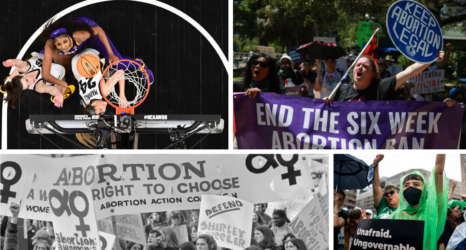The Supreme Court voted today in a 5-3 decision to strike down draconian abortion restrictions in a case about Texas House Bill 2 (HB2), declaring the state’s law and thusly others modeled after it across the nation to be unconstitutional. However, looking forward to the fall elections, abortion rights advocates cautioned against complacency, with the next president likely to shape the Court for a generation.
Whole Woman’s Health v. Hellerstedt was centered on HB2, a TRAP (Targeted Regulation of Abortion Providers) law passed in 2013 that required healthcare providers at each abortion clinic in Texas to have admitting privileges at a hospital within 30 miles from the clinic and dictated that every health care facility offering abortion care must adhere to the same building standards required for ambulatory surgical centers (ASCs). HB2 had an enormous impact on women seeking abortions in Texas and forced over half of clinics in the state to close due to these extraneous and medically unnecessary requirements.
“Today women across the nation have had their constitutional rights vindicated,” President and CEO of the Center for Reproductive Rights Nancy Northrup said in a press release. “The Supreme Court sent a loud and clear message that politicians cannot use deceptive means to shut down abortion clinics.” The Center filed the Supreme Court suit on behalf of Whole Woman’s Health, a Texas clinic.
Though HB2 was proposed under the guise of “protecting the health of Texas women,” it was clearly an attempt to target and shut down Texas abortion clinics by forcing them to comply with outrageous regulations. To force each abortion care provider to convert to ASC status would be to force them to “essentially become mini-hospitals,” a task which the vast majority of abortion clinics in the state do not have the resources to complete.
According to the Center for Reproductive Rights, the ASC and admitting privileges measures would have combined to shut down all but nine or 10 abortion providers in the state. Since the law was first passed in Texas, nearly 53% of the abortion-providing facilities in the state have shut down or halted abortion services; 11 clinics closed the very same day the admitting-privileges provision took effect. HB2 hit poor women of color the hardest, decimating abortion access in the lower Rio Grande Valley and requiring women there to make an over 500 mile round-trip to obtain an abortion. The drastically decreased number of abortion clinics in Texas left clinics overwhelmed and had women waiting for weeks to get appointments, paying higher fees for care, and traveling hundreds of miles to secure the procedures they need. It also had women attempting to self-abort and crossing state lines to access abortion care.
The Court’s decision today grants women across America hope and reassurance that they will be able to dictate their own futures and maintain control and sovereignty over their bodies—but it didn’t push the movement for abortion rights forward. Instead, it leaves in its wake the damage already done by TRAP laws around the country. TRAP laws have not only closed clinics in Texas but, as Ms. highlighted in our Spring 2016 issue, have also closed an estimated six abortion clinics in Ohio, two in Virginia, five in Pennsylvania, one in Tennessee and 12 in Arizona. Many of these clinics will not be able to re-open after losing their staffs and and building leases.
“This is a victory for women’s health and lives in Texas and throughout the nation,” Eleanor Smeal, president of the Feminist Majority, said in a statement today. “But women’s rights advocates must continue to fight until women’s bodies are no longer stripped of their humanity and used as battling grounds for political gains in male-dominated state legislatures and Congress. We must not let down our guard. Until the Supreme Court slams shut the door that permits state legislatures and Congress to chip away at this fundamental right and decides, once and for all, that women have the right to make their own health decisions, including whether or not to have an abortion, we must continue to elevate the voices of the majority of women across the country who demand this right.”
The Supreme Court first acknowledged the constitutional right of women to abortions in the 1973 Roe v. Wade case and further affirmed that ruling in its decision in 1992 in Planned Parenthood v. Casey. Today’s decision affirms both. “So long as this Court adheres to Roe v. Wade and PP v. Casey,” Justice Ruth Bader Ginsburg wrote in her concurring opinion, “TRAP laws like HB2 that do little or nothing for health, but rather strew impediments to abortion cannot survive judicial inspection.”
However, Casey imposed a new standard that required judges to consider whether abortion laws impose an “undue burden” upon women seeking abortions—and while the Court’s decision said that Texas’ TRAP law violated this standard, the explicit right to an abortion remains to be won for women in the U.S. Since the Court’s decision today didn’t shift the law away from an “undue burden” standard, the door remains wide open for anti-abortion extremists and politicians to craft new ways to legally interfere with a woman’s right to abortion access.
The Court’s decision today is also a reminder of the threat vacancies on the Supreme Court can pose to women’s lives. Given that the Supreme Court remains a battleground for abortion rights, the appointment of one or more new Justices—likely to be made by the next president—has become all the more important. “In the 2016 election, many candidates for state legislature, Congress, and the presidency, are pledged to ban access to abortion and to limit access to birth control,” Smeal added in her statement today. “The balance of the Supreme Court will be determined by the next president. The closeness of this decision calls attention to the high stakes for women in this next election and for the next quarter of a century. In fact, this election may determine for millions of women their reproductive fate and the course of their lives.”
Today certainly marks a victory in the fight for reproductive rights—but this ruling is also a stark reminder of how precarious our progress remains.





